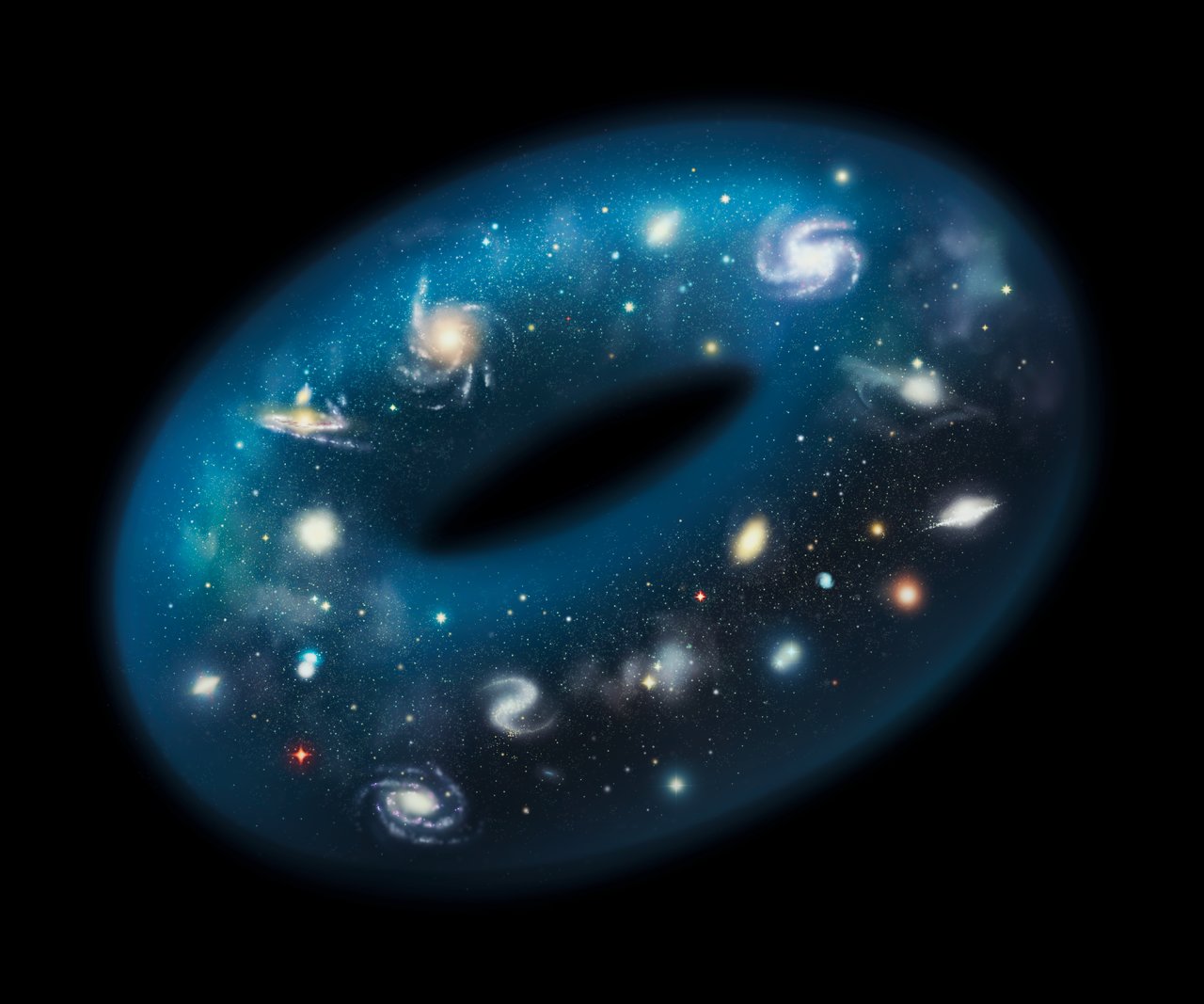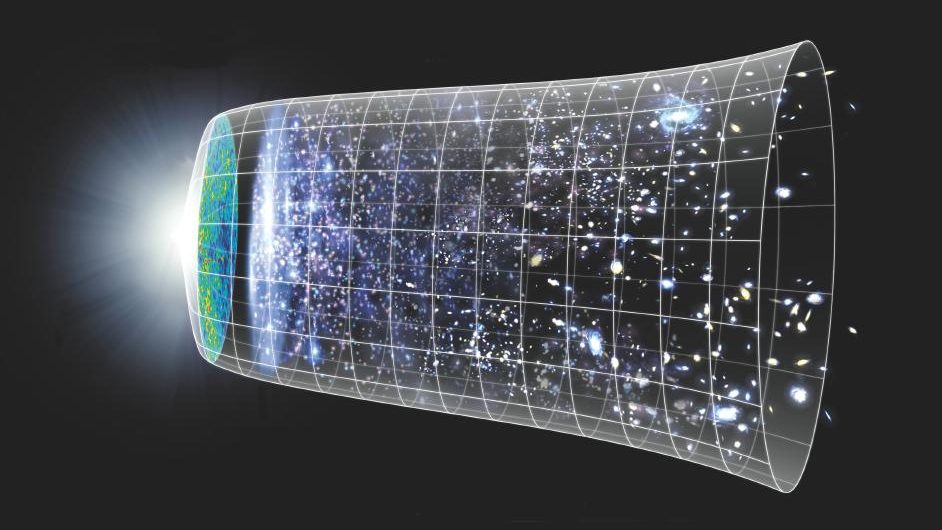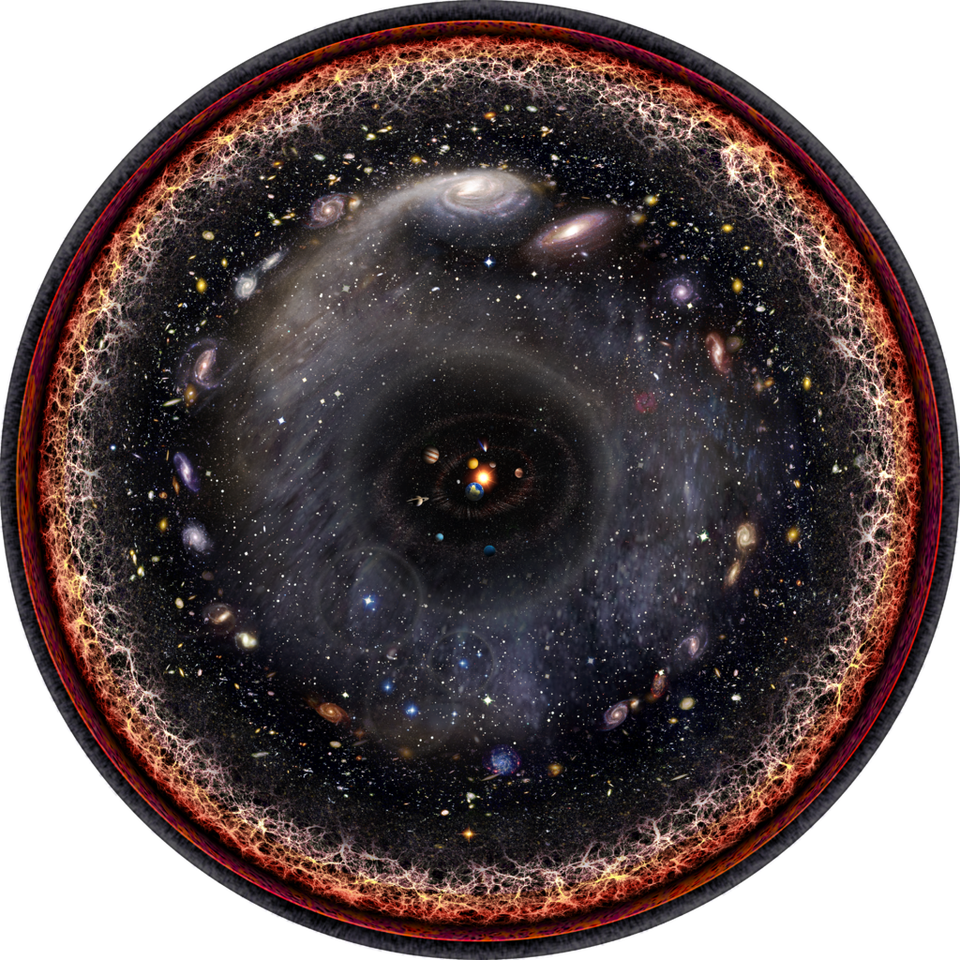Ask Ethan: What would happen if you traveled in a straight line forever?

- From our position within the Universe, our view of what's observable to us is fundamentally limited by the speed of light and the time elapsed since the hot Big Bang.
- On larger scales than what we can see, the Universe could be closed, it could be curved, and it could even loop back on itself.
- So what would happen, then, if you went into space and traveled in a straight line forever? Could you ever return to your starting point? It's a fascinating question, and we have the answer.
The Universe is a vast, wondrous, and strange place. From our perspective within it, we can see out for some 46 billion light-years in all directions. Everywhere we look, we see a Universe filled with stars and galaxies, but are they all unique? Is it possible, perhaps, that if you look far enough in one direction and see a galaxy, that you’d also see that same galaxy, from a different perspective, in the opposite direction? Could the Universe actually loop back on itself? And if you traveled far enough in a straight line, would you eventually return to your starting point, just as if you traveled in any one direction for long enough on the surface of the Earth? Or would something stop you?
It’s a fascinating question to consider, and one that Bill Powers wants us to investigate, asking:
“Space and time are mind-boggling to me. It seems like if you traveled in a straight line, you could travel forever. What would stop you? A wall? [And if so,] what’s on the other side of the wall?”
Although it sounds nonsensical, the answer is both. You could travel forever, and also, something would stop you. The key lies in understanding the expanding Universe, which itself is one of the most mind-boggling concepts of all.

When we look out into the cosmos, we’re not seeing objects as they exist right now. From our perspective, it’s been 13.8 billion years since the Big Bang occurred, but literally everything else that we see is younger than that.
Why is that the case?
The Big Bang occurred everywhere at once, and if we were located anywhere else in the Universe, that same 13.8 billion years would have elapsed. But if we looked at planet Earth from that location, we’d have to take into account that we aren’t seeing Earth as it is today. Instead, we would see Earth as it was when the light that’s arriving at this moment was emitted from it. We would see Earth’s past.
If we were on the Moon, that light would be ~1.3 seconds old. If we were on a planet orbiting Alpha Centauri, that light would be 4.3 years old. And if we were in the Andromeda galaxy, that light would be 2.5 million years old.

The same principle is at play whenever we look at a distant object from our own perspective: we’re seeing those objects as they were when the light that’s arriving now was emitted. Only, if we look farther away than moons, planets, stars, and galaxies within our Local Group, there’s an additional factor at play: the space that the light is traveling through is expanding.
The 20th century discovery that the Universe is expanding was one of the biggest revolutions in our understanding of the cosmos. The farther away a distant galaxy is — assuming it’s not gravitationally bound to our own — the greater the amount its light is redshifted, or stretched to longer wavelengths.
There are three things in the Universe that can commonly cause a redshift:
- when a source and the observer are moving relatively away from one another,
- when the emitted light needs to climb out of a large gravitational potential well,
- or when the space between two objects expands during the light’s journey.
Although the first two effects can be substantial over short distances, on the largest cosmic scales, only the expansion of the Universe matters.

The fact that the Universe is expanding is important for a number of reasons, especially from a cosmic perspective. It allows us to infer our cosmic history, and our emergence from a hotter, denser, more uniform, more rapidly expanding state. It allows us, if we can measure how the expansion rate has changed over time, to infer the various types and ratios of energy that make up the Universe.
And, if we can know both how the Universe is expanding and what’s in it, we can predict how it will expand into the far future, and what our ultimate cosmic fate will be.
“Yeah, yeah, fine,” I can hear you grumble. “But what, then, does that have to do with the question of what would happen to you if you traveled in a straight line, forever, through the Universe?”
We’re almost ready to get there, but first, I want you to consider what your options would be if you traveled in a straight line, forever, through a Universe that wasn’t expanding, but rather, through one that was static and unchanging.

In the case of a static, unchanging Universe, everything would depend on what we know, mathematically, as the topology of the Universe. One of the great revolutions brought about by Einstein’s General Relativity was the realization that space itself isn’t simply describable by a rigid, absolute, three-dimensional grid made out of straight lines. Instead, space itself is necessarily curved by the presence (or absence) of matter and energy. Where you have a large, overdense collection of matter and/or energy, you have a greater amount of (positive) spatial curvature, and wherever there’s either a below-average amount or even a negative amount, you get negative curvature.
Well, in General Relativity, there can also be a global structure to the spacetime you inhabit. Your spacetime can be positively curved, like a (higher-dimensional) sphere; it can be negatively curved, like a (higher-dimensional) saddle; or it can be flat, where there’s neither positive nor negative curvature on the largest, overall scales.
While it’s easy to see how a positively-curved space can be finite and closed, it’s a little less intuitive to realize that a flat space could be finite and closed as well, but that’s also the case. To understand, simply imagine a long, straight cylinder, and then bending that cylinder into a donut-like shape until the two ends connect. This shape — known as a torus — is both spatially flat and also finite and closed.

If the Universe weren’t expanding, you could imagine only two possibilities.
- The Universe could be finite and closed, regardless of its curvature. If you traveled far enough in one direction, which only means traveling in one direction for long enough, you’ll eventually return to your starting point. Even if space itself is topologically weird, like a Möbius strip or a Klein bottle, you can simply keep on going, and eventually you’ll return to where your journey began.
- Or the Universe could be infinite and open, again, irrespective of its curvature. No matter how far you traveled in any direction, or how long you spent on that journey, you’d always find that you were encountering “new space” that you had never encountered before. There would be nothing to stop you, and yet, nothing to enable you to return to where you started, other than turning around and reversing your journey.
When we’ve looked at the Universe in every way we know how — at the galaxies within it, at the gas and plasma we can map, at the radiation emitted by stars, molecules, and even the Big Bang itself — we’ve searched for repeating patterns, hoping to find evidence that the Universe might be finite on scales that we can observe.

But there’s no such luck. In fact, all across the entire Universe, we’ve been able to confidently state that there are no repeating structures, no locations where we see objects in one direction that match objects in another direction, and no patterns in even the earliest light that can be identified as being identical across two different regions.
In fact, the only time we’ve ever seen multiple images of the same astronomical source has been when there’s a large gravitational mass located somewhere in space, and the light from a background source gets bent and distorted into multiple different paths that can all successfully arrive at our eyes. While this phenomenon — known as strong gravitational lensing — is both optically and scientifically phenomenal, it’s limited to very narrow, localized angles and regions on the sky.

But now, we come to the simultaneously important and uncomfortable reality of the situation: the Universe isn’t static, but rather is expanding. However, it isn’t only expanding; because it’s filled with matter and energy, it’s also gravitating as it’s expanding. You can imagine, at least in principle, a few possibilities for what this would mean for our far future.
- The gravitating effect could be more powerful than the current expansion, which would mean the Universe would expand for a time, reach a maximum size, and then reverse directions, contracting, and potentially even ending in a “Big Crunch” just as we began with a “Big Bang.”
- The gravitating effect could be less powerful than the current expansion, which means the Universe will expand forever, although the expansion rate could continue to slow down.
- The effect of gravitation and the initial expansion could balance each other perfectly, which means the expansion rate will asymptote to zero, but will never reverse itself or recollapse.
For most of the 20th century, these were the three major possibilities considered by cosmologists, and the quest to measure the expansion rate and the expansion history of the Universe was meant to discern between these options.

If the first option described our reality, you couldn’t travel in a straight line forever, because the Universe would only exist for a finite amount of time, so you would run into a sort of wall: a wall in time. You could return to your starting point before the Universe completely recollapsed by traveling in that straight line, but you’d potentially only be able to enjoy it for a short while.
If the second or third option described our reality, you’d eventually be able to “catch up” to any galaxy or object that was out there, even the ones that are expanding away from us extremely rapidly. Over time, the expansion rate would keep on dropping, and progressively more and more distant galaxies would first come into view, and then eventually be overtaken by a space traveler who kept on moving in that same straight line for long enough. If the Universe were infinite, we’d eventually be able to catch up to anything; if the Universe were finite, we’d eventually be able to return to our starting point.
However — and this is a huge “however” — none of these scenarios adequately describe how our Universe is actually expanding. In reality, we live in a Universe dominated by dark energy: a form of energy inherent to the fabric of space that always maintains a constant energy density. Even as space itself expands, the density of dark energy never drops, and hence, the expansion rate always remains positive and finite. This changes our expected fate dramatically, and means that if you were to put your finger down on any galaxy that wasn’t gravitationally bound to us, you’d find that, once it expanded beyond a certain distance from us, we’d never be able to catch up to it. Effectively, it will have disappeared from our reach, no matter how long we traveled for and no matter how close to the speed of light we were able to reach.

And that, quite sadly, provides us with our answer. If you traveled in a straight line, you could travel forever in time, but you’d only be able to reach a very small proportion of even the observable Universe. Everything beyond our current cosmic horizon — beyond the limit of what we can presently see — is forever beyond our ability to reach. In fact, today, everything that’s farther than 18 billion light-years away is already unreachable. This means that, of everything we can observe, only ~6% of the objects out there are potentially reachable by us. With every single second that passes, there are tens of thousands of stars that the expanding Universe pushes over that critical boundary, causing them to transition from “reachable” to “unreachable,” even if we left on a journey for them, today, at the speed of light.
Despite all the possibilities that account for the shape, curvature, and topology of the Universe, traveling in a straight line, even forever, can never return you to your starting point. The combined facts that:
- the Universe is expanding,
- dark energy is causing the expansion to accelerate,
- it’s already 13.8 billion years after the Big Bang,
- and the Universe does not repeat and is not finite on scales smaller than ~46 billion light-years,
ensure that we’ll never be able to circumnavigate the Universe the way we can circumnavigate the Earth. The Universe may, on some very grand cosmic scale, truly be finite in nature. But even if it is, we’ll never be able to know. While we can travel through space as far as we like, as fast as we can, for as long as we can imagine without end, most of what’s in the Universe is already forever beyond our reach. There is a cosmic horizon that limits how far we can travel through the expanding Universe, and for objects more than ~18 billion light-years away at present, they’re already effectively gone.
Send in your Ask Ethan questions to startswithabang at gmail dot com!





